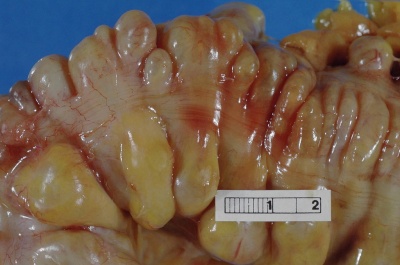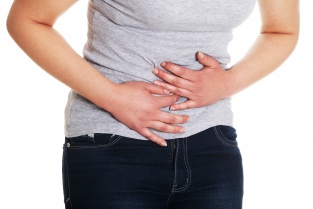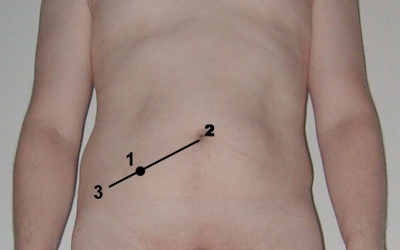Diverticulitis
Top Contributors - Katie Countryman, Cate Hurst, Khloud Shreif, Elaine Lonnemann, Lucinda hampton, Kim Jackson, WikiSysop, 127.0.0.1, George Prudden and Karen Wilson
This article or area is currently under review and may only be partially complete. Please come back soon to see the finished work! (16/03/2024)
Introduction[edit | edit source]
Colonic diverticulitis is a possible adverse result of colonic diverticulosis that develops adjacent to blood vessels that penetrate these layers. Colonic diverticulosis is characterized by the protrusion of both mucosa and submucosa layers of the colon and sigmoid colon being the most affected segment of the colon[1]. However, in recent studies its prevalence is more common in younger ages for years it was believed to be associated with old age above 50 years old as it was in united Kingdom[2][3].
Diverticulosis is mainly asymptomatic whilst acute diverticulitis is a potentially life-threatening illness. It develops in approximately 10-25% of individuals with diverticulosis[4]. But recent data, utilizing colonoscopy and CT scans, suggest the actual risk is below 5%[5].
Epidemiology[edit | edit source]
Diverticulitis is a complication of diverticulosis, and the demographics of the condition are much alike. It tends to be more common in western world compared to that in Asian, but recently the incidence increased by 0.5% in Asian countries. However advanced colonoscopy and CT scan, In USA diverticulitis remains a common condition as over half of Americans over 60 years having diverticulosis[5]. It tends to increase with patient age but in recent decades there is an increase in diverticulitis in young age, there was a 132% increase in diverticulitis cases among individuals aged 40-49 between 1980 and 2007[5]. With the highest hospitalization rates for diverticulitis are among white individuals (62 per 100,000), followed by similar rates in African Americans and Hispanics (about 30 per 100,000), and the lowest in Asians (10 per 100,000).
On another side, Immigrants from non-Western countries initially show a reduced risk of being hospitalized for diverticular disease compared to those native to Western countries, but this risk escalates as the duration of their stay in the new country increases[5] a study suggested diverticular disease of the colon tends to be an acquired disorder and the change in life style may has an impact on its development[6].
Etiology[edit | edit source]
Risk Factors include: Increased age; Constipation; Sedentary lifestyle; Obesity; Smoking; NSAIDS; Red meat[7]
Colonic diverticular development may involve involve bowel wall abnormality, increased intraluminal pressure, and lack of dietary fibre. Diverticulitis is the result of obstruction of the neck of the diverticulum (outpouch), with consequential inflammation, perforation, and infection. A walled of region of soft tissue may later progress to abscess formation and generalised peritonitis.[8]
Characteristics/Clinical Presentation[edit | edit source]
The presentation and signs and symptoms can vary for each individual patient. Although many of the patients have the same side effects, they are usually experienced at different intensities and at various times. Some of the most common signs and symptoms that are present with the diverticulitis diagnosis include the following[9]:
- Sudden abdominal pain, usually in the left lower quadrant abdomen (49%), and is often associated with an increase in inflammatory markers and temperature.
- Palpable mass
- Irregular bowel movements and change in bowel habits.
- Bowel sounds absent or decreased
- Flatulence
- Fever
- Nausea/ Vomiting
- Bloody stools
- Increased frequency of urination[7][3]
Possible complications include perforation of bowels, abscess formation that seen in around 17% of patients[10], fistula formation, gastrointestinal hemorrhage, obstruction, bleeding, and perforative peritonitis in 1-2% of patients[11].
Diagnosis[edit | edit source]
Diverticulitis is typically diagnosed during an acute attack due to complaints of severe abdominal pain. Diverticulitis diagnosis is typically confirmed with the presence of constitutional symptoms, bloody stools, elevated white blood cell count, and with the use of imaging studies.[9] Due to the prevalence of abdominal pain in a number of conditions, the physician may order a number of tests to rule out other causes of abdominal pain and associated symptoms.
CT scan:
Endoscopic evaluation:
Depending on the severity of the condition, diverticulitis can be treated with rest, changes in diet or antibiotics, and in severe cases may require surgery.[12]
Treatment[edit | edit source]
Treatment depends on a range of factors, in particular comorbidities and stage of the disease.
- Localised disease: conservative management with intravenous antibiotics and rehydration usually is enough.
- Surgery may be required if a patient has a complication (abscess, fistula formation, bowel obstruction), has had multiple episodes of uncomplicated diverticulitis, or is immune-compromised. Surgery may be recommended or it may require emergency surgery[8]. There are two main types of surgery[12]: Primary bowel resection/laparoscopic procedure; Bowel resection with colostomy[7].
Prevention of diverticulitis is from a variety of lifestyle changes. Adherence to a high-fiber diet, decreased red meat intake, prevention of constipation with an adequate balance of fluids and fiber intake, cessation of smoking, and regular exercise during remission may decrease the risk of diverticulitis.[7]
Physical Therapy Management[edit | edit source]
As a physical therapist, the optimal goal is to help a patient return moving in a functional way. Being active helps decrease the chances of developing diverticulitis because movement helps promote proper bowel movement. Therapists can help patients with proper exercise, strengthening, and positioning to help them get the best and safest movement possible. Patients with diverticulitis must be cautious about doing activities that increase the pressure on their abdomen so further herniation does not happen[9].
Exercise can be seen as a protective mechanism because it is promoting movement to the body, but also the different systems that could be affected from a sedentary lifestyle[9]. Depending on the symptoms that the patients present with, it is up to the therapist to do appropriate screening or testing to identify what is involved and what is causing the issues.
A common area of pain is the left lower quadrant, including referred pain to low back or thigh from an abscess[13]. For example, the obturator test, manual muscle testing and palpation of the illiopsoas ,or McBurney’s point palpation can be done to look at positive or negative testing of referred pain to the thigh[9][13].
References[edit | edit source]
- ↑ Imaeda H, Hibi T. The burden of diverticular disease and its complications: west versus east. Inflammatory intestinal diseases. 2018 Aug 7;3(2):61-8.
- ↑ Painter NS, Burkitt DP. Diverticular disease of the colon: a deficiency disease of Western civilization. British medical journal. 1971 May 5;2(5759):450.
- ↑ 3.0 3.1 Bhatia M, Mattoo A. Diverticulosis and diverticulitis: epidemiology, pathophysiology, and current treatment trends. Cureus. 2023 Aug 8;15(8).
- ↑ Jacobs DO. Diverticulitis. New England Journal of Medicine. 2007 Nov 15;357(20):2057-66.
- ↑ 5.0 5.1 5.2 5.3 Strate LL, Morris AM. Epidemiology, pathophysiology, and treatment of diverticulitis. Gastroenterology. 2019 Apr 1;156(5):1282-98.
- ↑ Hjern F, Johansson C, Mellgren A, Baxter NN, Hjern A. Diverticular disease and migration–the influence of acculturation to a Western lifestyle on diverticular disease. Alimentary pharmacology & therapeutics. 2006 Mar;23(6):797-805.
- ↑ 7.0 7.1 7.2 7.3 Goodman CC, Fuller KS. Pathology: implications for the physical therapist. 3rd ed. St. Louis: Saunders Elsevier, 2009.
- ↑ 8.0 8.1 Radiopedia Colonic diverticulosis Available:https://radiopaedia.org/articles/colonic-diverticulosis?lang=gb (accessed 22.1.20230
- ↑ 9.0 9.1 9.2 9.3 9.4 Goodman CC, Snyder TE. Differential diagnosis for physical therapists: screening for referral. 4th ed. St. Louis: Saunders Elsevier, 2007.
- ↑ Mali J, Mentula P, Leppäniemi A, Sallinen V. Determinants of treatment and outcomes of diverticular abscesses. World Journal of Emergency Surgery. 2019 Dec;14:1-9.
- ↑ Edna TH, Jamal Talabani A, Lydersen S, Endreseth BH. Survival after acute colon diverticulitis treated in hospital. International journal of colorectal disease. 2014 Nov;29:1361-7.
- ↑ 12.0 12.1 MCS. Diverticulitis Disease and Condition [Internet]. - Mayo Clinic. 2014 [cited 2016Mar31]. Retrieved from: http://www.mayoclinic.org/diseases-conditions/diverticulitis/basics/definition/con-20033495
- ↑ 13.0 13.1 Hammond N. Left Lower-Quadrant Pain: Guidelines from the American College of Radiology Appropriateness Criteria. American Family Physician. 2010;82(7):766-770.










